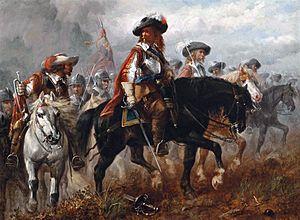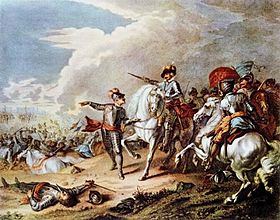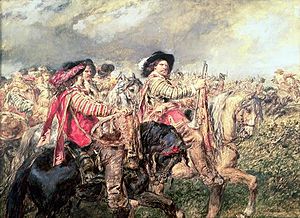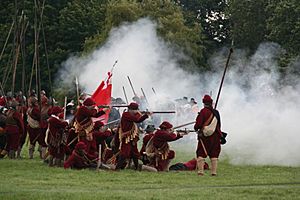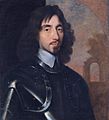Battle of Naseby facts for kids
Quick facts for kids Battle of Naseby |
|||||||
|---|---|---|---|---|---|---|---|
| Part of the First English Civil War | |||||||
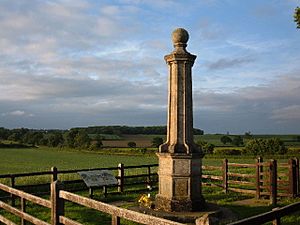 Battle memorial, and beyond the fields of Broad Moor, the site of the battle |
|||||||
|
|||||||
| Belligerents | |||||||
| Commanders and leaders | |||||||
|
|||||||
| Strength | |||||||
|
14,000
|
7,400
|
||||||
| Casualties and losses | |||||||
| 400 killed and wounded |
|
||||||
The Battle of Naseby was a very important fight during the First English Civil War. It happened on June 14, 1645. This battle was between the army of King Charles I (called the Royalists) and the Parliamentarian army. The Parliamentarian army was known as the New Model Army. It was led by Sir Thomas Fairfax and Oliver Cromwell. The battle took place near the village of Naseby in Northamptonshire, England.
Before this battle, the Royalists had captured the town of Leicester. Fairfax was then told to stop trying to capture Oxford, which was the Royalist capital. Instead, he had to find and fight the King's main army. Fairfax chased the Royalist army, which was trying to go north. King Charles had to choose between retreating or fighting. He decided to fight, fearing his army would lose hope if they kept running away. After a tough fight, the Parliamentarian army almost completely destroyed the Royalist forces. This was a huge win for Parliament.
King Charles lost most of his experienced soldiers and officers. He also lost all his cannons, supplies, and personal belongings. This meant the Royalists could never again put together such a strong army. Among the captured items were the King's private letters. These letters showed he was trying to get help from Irish Catholics and foreign soldiers. When Parliament published these letters, it gave them more reasons to finish the war.
Contents
Why the Battle Happened
After some battles in 1644, Parliament decided to make their armies better. They created the New Model Army. This new army was not controlled by local leaders. At the same time, Oliver Cromwell helped pass a law called the Self-denying Ordinance. This law said that members of Parliament could not be army commanders. The idea was to stop arguments among commanders. It also helped remove some noblemen from their army roles. Many of these noblemen were not fully against the King.
In early 1645, many of King Charles's advisors wanted him to attack the new Parliamentarian army. But Prince Rupert of the Rhine, who was the King's main military advisor, suggested something else. He wanted to march north to get back control of Northern England. He also hoped to join forces with Royalists in Scotland. The King agreed to this plan. However, he had to send some of his army, including 3,000 horsemen, to the West Country. This group, led by Lord Goring, stayed to hold the area and continue the Siege of Taunton.
Meanwhile, the New Model Army was told to attack Oxford, the King's capital. King Charles was happy about this at first. He thought it would keep Fairfax busy and away from his northern march. But then, at the end of May, he heard that Oxford was running out of food. To distract Fairfax, the Royalists attacked Leicester on May 31. After taking Leicester, Prince Rupert and the King changed their minds. They decided to march south to help Oxford. They told Goring to join them, but he refused to leave the West Country.
Parliament was worried about losing Leicester. So, they told Fairfax to stop attacking Oxford and fight the King's main army instead. Fairfax marched north from Oxford on June 5. On June 12, his soldiers clashed with Royalist guards near Daventry. This told the King that Fairfax was close. On June 13, the Royalists were heading for Leicester to get more soldiers from Newark. They were near Market Harborough.
Fairfax really wanted to fight them. He held a meeting with his officers. Oliver Cromwell arrived with more cavalry soldiers. The New Model Army chased the Royalist army. Late that day, Henry Ireton, who was Cromwell's son-in-law and second-in-command of the cavalry, attacked a Royalist outpost at Naseby. This was about 6 miles (10 km) south of the King's main army. The King now had to fight or retreat with Fairfax right behind him. On June 14, the King decided to fight. He ignored Rupert's advice and was convinced that retreating would make his soldiers lose heart.
How the Battle Unfolded
The morning of June 14 was very foggy. This meant the armies could not see each other at first. The Royalist army was on a strong hill between the villages of Little Oxendon and East Farndon. This was about 2 miles (3 km) south of Market Harborough. The Royalist scout, Sir Francis Ruce, was sent to find the Parliamentarian army. He rode south but saw nothing, perhaps because he was careless. Prince Rupert himself rode forward and saw some Parliamentarian cavalry seemingly leaving. He wanted to take the high ground at Naseby ridge. So, he ordered the Royalist army to move forward.
Fairfax first thought about staying on the northern slopes of Naseby ridge. But Cromwell thought this spot was too strong. He believed the Royalists would not attack it. He is said to have told Fairfax, "Please, move back to that hill over there. That might make the enemy attack us." Fairfax agreed and moved his army back a little.
The Royalists did not see Fairfax's position until they reached Clipston. This was just over a mile north of Naseby ridge. It was clear that the Royalists could not go back to their first position without being attacked by the Parliamentarian cavalry. Rupert moved his army to the right. The ground there seemed better for his cavalry, and he got ready for battle.
Army Positions
Royalists
The Royalist army stretched for about a mile and a half. Their right side had between 2,000 and 3,000 cavalry led by Rupert and his brother Prince Maurice. The middle of their army had three groups of foot soldiers (infantry brigades). These were led by Lord Astley. They also had a group of horsemen helping them. On the left side were 1,500 "northern horse" cavalry. These were soldiers from northern England. They kept fighting even after their homes were taken over by Parliamentarians. Sir Marmaduke Langdale led them. The King kept a small group of soldiers as a backup. This included his own and Rupert's foot soldiers and his personal guards.
Parliamentarians
Fairfax had placed his army on the ridge a mile north of Naseby. Some of his soldiers were hidden behind the top of the hill. Henry Ireton led the left side with five and a half groups of cavalry. The foot soldiers, led by Sir Philip Skippon, were in the middle. They had five groups in the front and three groups behind them. About 300 musketeers (soldiers with guns) were placed in front. Two companies of soldiers were kept as backup. A drawing of the battle shows 11 cannons placed between the foot soldier groups. These cannons did not do much in the battle. Their first shots went too high. After that, the Royalist and Parliamentarian foot soldiers were too close to each other to use the cannons safely. Oliver Cromwell led the right side with six and a half groups of cavalry.
The Parliamentarian army was about 2 miles (3 km) long. They were wider than the Royalist left side. Their own left side was protected by the Sulby Hedges, just like the Royalists' right side. At the last moment, as the Royalists started to move forward, Cromwell sent a group of dragoons (soldiers who ride horses but fight on foot) under Colonel John Okey into the Sulby Hedges. From there, they could shoot at the side of Rupert's cavalry.
The Fighting Begins
The Royalist foot soldiers in the middle attacked first. Rupert kept his cavalry ready so that horsemen and foot soldiers could attack at the same time. Skippon's Parliamentarian foot soldiers moved forward to meet the Royalist foot. There was only time for one round of gunfire. Then, both sides fought hand-to-hand. The experienced Royalist soldiers used their swords and the ends of their muskets. Sir Edward Walker, the King's war secretary, said that the foot soldiers were so close they could barely see each other before firing. He said the Royalists did "notable Execution" with swords and musket butts. Skippon was hurt by a bullet, but he stayed in the fight to keep his soldiers from panicking. Even so, the Parliamentarians were pushed back.
On the Parliamentarian left, the opposing cavalry groups stopped briefly. Then they charged into each other. Ireton's own group pushed back the Royalists they faced. But then Ireton led some of his men to help the struggling Parliamentarian foot soldiers. His horsemen were driven back by Royalist soldiers with long spears. Ireton himself was knocked off his horse, hurt in the leg and face, and taken prisoner. At the same time, the second line of Royalist cavalry broke most of the Parliamentarian horsemen. Some of Ireton's groups, on the far left, were saved by the gunfire from Okey's dragoons. But the others ran away, some not stopping until they reached Northampton, about 15 miles (24 km) away. All of the Royalist right side had been used to defeat Ireton. None were left in reserve. Rupert did not or could not gather his horsemen, who galloped off the battlefield chasing the fleeing Parliamentarians.
Meanwhile, the Parliamentarian right side of horsemen, led by Cromwell, faced the Royalist Northern Horse. Neither side wanted to charge to help their foot soldiers while the other could attack their side. After about half an hour, the Royalist cavalry began to charge. Cromwell's troops moved to meet them. Langdale's men were not only outnumbered two to one, but they had to charge up a hill with bushes and rabbit holes. After a short fight, they were defeated.
Unlike Rupert, Cromwell still had about half of his cavalry ready. Only the front line of his cavalry had fought Langdale. He sent only a few groups after Langdale. Then, he turned his remaining soldiers to attack the left side and back of the Royalist center. At about the same time, Okey's dragoons got on their horses. They charged from the Sulby Hedges against the right side of the Royalist foot soldiers. Some of Ireton's groups, who had partly regrouped, also attacked.
Some of the Royalist foot soldiers, now surrounded, began to drop their weapons and ask to surrender. Others tried to fight their way out. One group, thought to be Rupert's "bluecoats" (named for their uniforms), stood firm. They fought off all attacks. One person who saw it said, "The Blue regiment of the Kings stood to it very stoutly, and stirred not, like a wall of brass." Finally, Fairfax led his own foot soldiers and horsemen against them from all sides. The bluecoats' resistance broke. Fairfax is said to have personally taken their flag. Evidence from the battle site suggests this happened about 1 km (0.6 miles) behind where the Royalists started.
At some point, the King tried to lead his personal guards to help his center. Or perhaps he tried to counter-attack Cromwell's soldiers. But a Scottish nobleman, the Earl of Carnwath, stopped him. He grabbed the King's horse and told him, "Would you go upon your death?" When the King turned away from the enemy, his guards also retreated in confusion.
Behind the Parliamentarian lines, Rupert's men had reached Naseby and the Parliamentarian supplies. The Parliamentarian guards there refused to give up. Rupert eventually gathered his men and led them back to the battlefield. By this time, it was too late to save the rest of the Royalist foot soldiers. Rupert could not get his men to charge again. Fairfax stopped and got his lines in order. When he started to advance again, Rupert's cavalry rode off the field.
Fairfax's soldiers chased the Royalist survivors who were running north towards Leicester. Many Royalists were killed when they mistakenly followed what they thought was the main road to Leicester. Instead, they ended up in the churchyard in the village of Marston Trussell. From there, they could not escape their pursuers.
What Happened After
Fairfax took back Leicester on June 18. He then led his army southwest to help Taunton and capture the Royalist-held West Country. The Royalist forces eventually surrendered in Truro, Cornwall. Leading Royalist commanders, including Lord Hopton and the Prince of Wales, fled to Jersey from Falmouth.
The main Royalist army had been completely broken at Naseby. The King had lost his best foot soldiers (including 500 officers), all his cannons, and many weapons. He did not have the money or resources to build another army of that quality. After Naseby, the Parliamentarian armies just had to clear out the last groups of Royalist fighters.
The Parliamentarians also captured the King's personal bags. Inside were letters that showed he planned to get help from Irish Catholics and Catholic countries in Europe. By publishing these letters, Parliament gained a lot of support. People wanted to fight the war until it was completely finished. Within a year, the First English Civil War ended with a Parliamentarian victory.
In Fiction
- The battle is part of Rosemary Sutcliff's historical novel Simon.
- Colonel Beverley, a character in Captain Marryat's The Children of the New Forest, was killed at Naseby.
- The battle is the historical setting for some murders in the TV show Midsomer Murders episode "The Dark Rider".
- In Arthur Conan Doyle's Sherlock Holmes novel The Adventure of the Musgrave Ritual, a character corrects someone about an ancestor's boot being worn at Naseby.
- The battle is shown in Catherine Darby's novel A Game of Falcons. In it, two neighbors from Kent, fighting on opposite sides, meet during the battle.
- The father of Alison, a character in Robert Neill's Burnaby Trilogy, was killed at Naseby.
- Lord Macaulay wrote a poem called "The Battle of Naseby".
- A made-up version of the battle is in the 1970 film Cromwell.
- The time after the battle is shown in the TV series By the Sword Divided. The King and his group hide at a fictional manor after the battle.
Images for kids
-
Sir Thomas Fairfax, Parliamentarian commander
See also
 In Spanish: Batalla de Naseby para niños
In Spanish: Batalla de Naseby para niños


